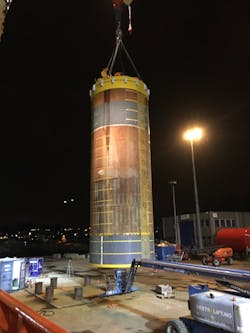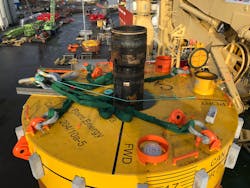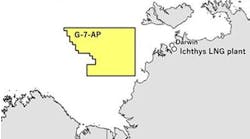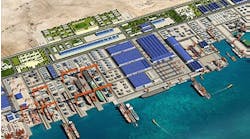Pre-rig installed conductor delivers strong foundation for Cambo appraisal well
Jostein Aleksandersen, Neodrill
Cutting environmental impact requires innovation to spearhead a step-change for offshore oil and gas operators. Focused on redefining the traditional methods and processes that have been in place since the 1980s, many companies are establishing new standards to take the industry into the 2020s. One such company is Stavanger-based Neodrill, known for its CAN (conductor anchor node) technology.
In February 2018, a CAN-ductor (CAN with integrated conductor) was deployed on Siccar Point Energy’s (SPE) Cambo field appraisal well. This was the first well SPE drilled as a license operator in the UK. The project was deemed a success with Colin Higgins, Wells Manager at SPE, calling the technology “game changing.”
Adapting a traditional suction anchor and a conventional conductor, CAN technology represents a merger between marine and drilling technologies to create a structural foundation for well construction, known as the CAN-ductor. Pre-rig, smaller marine vessels can be used for installation and recovery. Instead of drilling a 42-in. hole, running the conductor and carrying out cementing operations, a vessel is used to install the system ahead of the rig’s arrival. This process reduces the rig schedule by two to four days, and maintains the top-hole construction off the critical path for the drilling rig.
This technology also offers load capacities for single production wells. It mitigates operational risk by preventing mobilization of spud bottomhole assembly and conductor handling equipment on the rig, eliminates conductor and cementing failures, and delivers excellent inclination control.
The technology has been applied in more than 20 installations across the world, on wells of varying well and seabed conditions.
Cambo case study
Located in the west of Shetland, the Cambo field is in 1,100 m (3,609 ft) of water on the North Atlantic Margin. Characterized by soft seabed conditions, the risks and challenges are considerable. To combat this, the operator wanted to narrow the scope of the program. By eliminating the top-hole section of drilling entirely, CAN removes the time and cost uncertainty associated with deepwater drilling. Installed at a water depth of 1,082 m (3,550 ft), and a final inclination of just 0.20°, the project was successfully carried out under difficult weather conditions.
“The CAN provides great inertia to the operation,” Higgins said. “When the rig arrives on location it can wake up the transponders, run the 17½-in. assembly from the derrick, and drill approximately 840 m [2,756 ft] in the first 36 hours.”
Following the success of the appraisal well, SPE intends to use the CAN-ductor for the rest of the Cambo development. The first element of this project will be an optimization study on the technology. This will look at its design, with a view to examining how to deliver the required load capacity for the lifetime of the production wells.
The wells will be drilled using the CAN-ductor top-hole method, later phases will subsequently run an evolution of the technology, which is known at the CAN-integrator. This facilitates early production by enabling pre-rig well construction and marine operations. It acts as an integrator between drilling, SPS (subsea production system), and SURF (subsea, umbilical, riser, flowlines) installation operations. The SPS equipment is mounted on the CAN in the workshop before being covered with the integrator protection structure.
Lessons for deepwater projects west of Shetland
There are many lessons from the Cambo appraisal well that can help operators undertaking future harsh environment wells in this region.
Fatigue-related issues. The wellhead system is widely recognized as the ‘weak link’ in conventional well design. While wellhead fatigue due to first order wave motion was not a huge issue at this depth, VIV (vortex induced vibrations) on the riser did occur during the CAN-ductor supported appraisal well. For future wells, strakes on the riser will be used to combat this issue. BOP supports or pony (wellhead saver frame) could be considered to prevent further fatigue damage on this appraisal well.
Cost savings. The cost of a CAN is about half the cost of running a traditional conductor. These savings are primarily realized due to the installation method. For the Cambo development project there will be a considerable number of CANs. As a result, the most cost-efficient model is to install these in batches of three. It is estimated that the operator will save £1-2 million ($1.2-2.6 million) per well and in the region of £20 million ($26 million) over Phase 1 of the Cambo development project.
Green technology. Cutting environmental impact is the main challenge for all operators across all regions. The mounting pressure will continue to come from all stakeholders in the sector – including regulators and investors.
Following the Cambo appraisal well, a life cycle assessment report was carried out to determine the emissions savings offered by the technology across eight environmental impact categories, including climate change and human toxicity. Analyzed and compiled by Asplan Viak, the report found that its environmental impact is 21%-44% less than that of a conventionally drilled well.
It was found that the reduction of rig time by four days and the need for materials, such as cement and steel in well casings, were the main reasons for its strong environmental credentials. Advantages with respect to cost, logistics, transport, and HSE aspects were also found.
Weather issues. Between October and March, the window for weather-dependent work to be carried out is reduced in the west of Shetland. The technology’s pre-rig installation method means the wellhead foundation can be established in favorable weather conditions during the summer months. This process gives better operability for the high specification mobile offshore drilling units.
Conclusion
The success of the Cambo field appraisal shows the benefits of embracing newer, proven technologies. SPE’s use of this technology on the subsequent development phases will result in increased efficiencies by creating a shorter project execution time - resulting in a faster time to first oil. Other benefits, such as reduced operational risk, lower cost and a decreased CO2 footprint on the field development, highlight that the advantages of the technology are not just operational. •
About the author
Jostein Aleksandersen is CEO of Neodrill. He has spent more than 30 years in the oil and gas industry. During this time Jostein has held various positions, from Project Engineer to CEO, and has worked in all major offshore areas of the world. Jostein holds an MSc degree in Mechanical Engineering and a Doctorate Degree in Petroleum Engineering,




